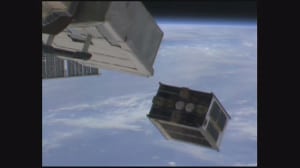Latest News
[Via Satellite 05-02-2016] The Japan Aerospace Exploration Agency (JAXA) has deployed the Philippines’ 50-kilogram microsatellite Diwata 1 from Japan’s Kibo module on the International Space Station (ISS). A joint project of the Department of Science and Technology (DOST) of the Republic of the Philippines, the University of the Philippines Diliman, Tohoku University, and Hokkaido University, the satellite launched March 23 during the ULA–Orbital ATK OA-6 supply mission. JAXA released the satellite on April 27.
Diwata 1 is equipped with an imaging device capable of four different magnifications, including a fish-eye lens camera, and a telescope with a ground resolution of 3 meters. It is expected to provide remote sensing information to solve social issues in the Philippines by observing meteorological disasters such as typhoons and localized heavy rains, and monitoring agriculture, fishery, forestry and the environment. Notably, the satellite carries a liquid crystal spectrum camera, which is a renovated version of the one aboard the Rising 2 satellite launched in 2014 led by Hokkaido and Tohoku universities. The camera is capable of taking images in 590 spectral bands, making the microsatellite more akin to traditionally larger satellite platforms. The Philippines spent roughly one year developing Diwata 1, and was in charge of the development costs.
Diwata 1 is the first 50 kg satellite JAXA has deployed from the Kibo module. The space agency also plans to increase the simultaneous deployment capacity of other CubeSat-class satellites such as those measuring 6U to 12U, and then 18U. JAXA anticipates supporting the deployment of more microsatellites from Asia and elsewhere, along with collaboration between foreign and Japanese institutions.
Get the latest Via Satellite news!
Subscribe Now